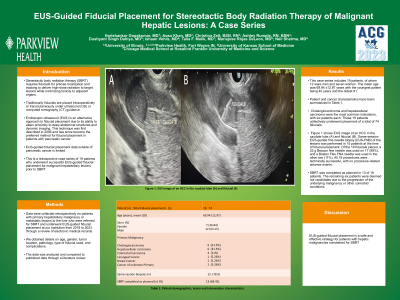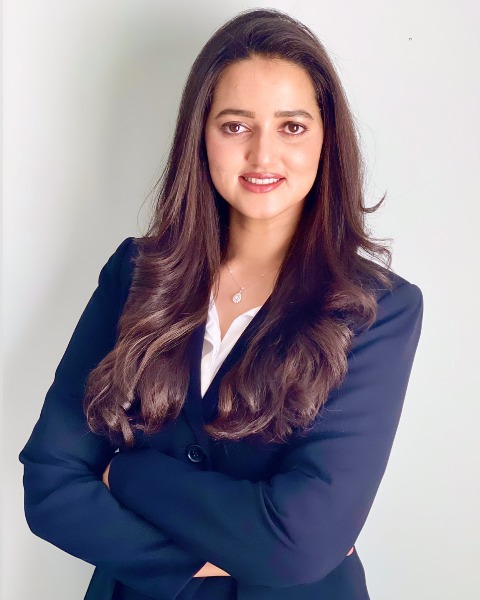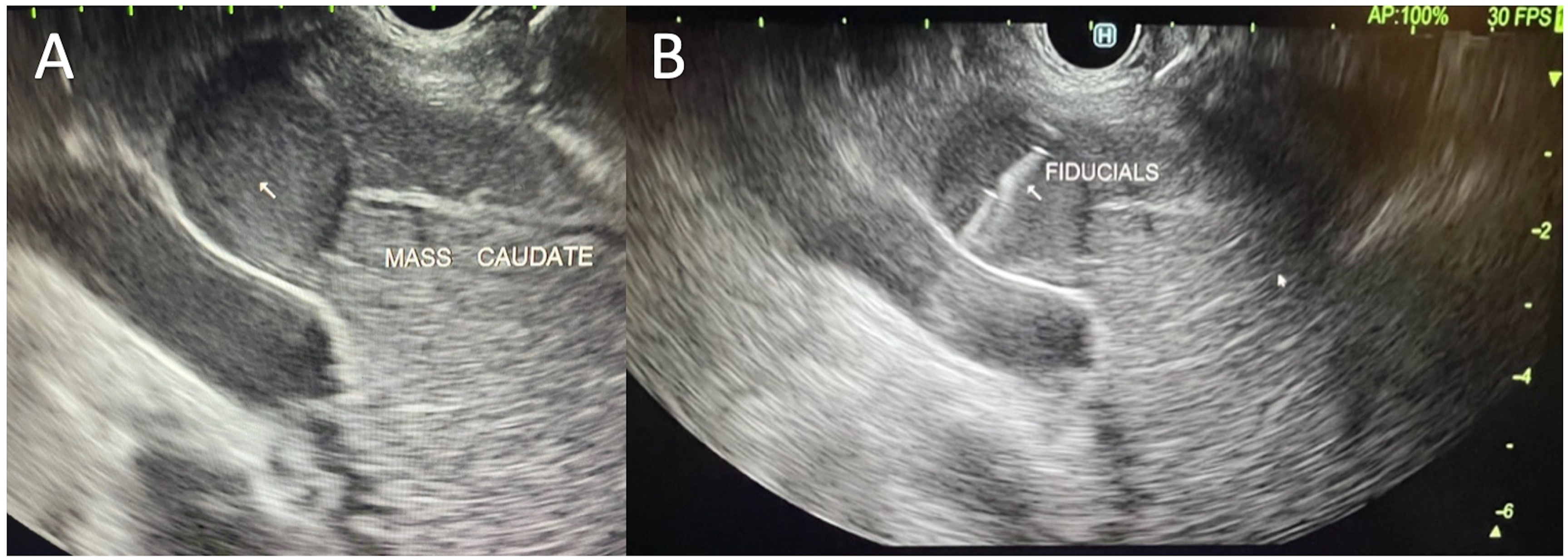Tuesday Poster Session
Category: Interventional Endoscopy
P3707 - EUS-Guided Fiducial Placement for Stereotactic Body Radiation Therapy of Malignant Hepatic Lesions: A Case Series
Tuesday, October 24, 2023
10:30 AM - 4:00 PM PT
Location: Exhibit Hall

Has Audio

Aqsa Khan, MD
Parkview Health
Fort Wayne, IN
Presenting Author(s)
Harishankar Gopakumar, MD1, Aqsa Khan, MD2, Christina Zelt, BSN, RN2, Ashley Rumple, RN, BSN2, Dushyant Singh. Dahiya, MD3, Ishaan Vohra, MD1, Talia F.. Malik, MD4, Mariajose Rojas DeLeon, MD2, Neil Sharma, MD2
1University of Illinois, Peoria, IL; 2Parkview Health, Fort Wayne, IN; 3University of Kansas School of Medicine, Kansas City, KS; 4Chicago Medical School at Rosalind Franklin University of Medicine and Science, North Chicago, IL
Introduction: Stereotactic body radiation therapy (SBRT) requires fiducials for precise localization and tracking to deliver high-dose radiation to target lesions while minimizing toxicity to adjacent organs. Traditionally fiducials are placed intraoperatively or transcutaneously under ultrasound (US) or computed tomography (CT) guidance. Endoscopic ultrasound (EUS) is an alternative approach to fiducial placement due to its ability to attain proximity to deep abdominal structures and dynamic imaging. This technique was first described in 2006 and has since become the preferred method for fiducial placement in patients with pancreatic cancer. EUS-guided fiducial placement data outside of pancreatic cancer is limited. This is a retrospective case series of 19 patients who underwent successful EUS-guided fiducial placement for malignant hepatobiliary lesions prior to SBRT
Methods: Data were collected retrospectively on patients with primary hepatobiliary malignancy or metastatic lesions to the liver who were referred for SBRT and underwent EUS-guided fiducial placement at our institution from 2018 to 2023 through a review of electronic medical records. We obtained details on age, gender, tumor location, pathology, type of fiducial used, and complications. The data was analyzed and compared to published data through a literature review
Results: This case series includes 19 patients, of whom 12 were men and seven women. The mean age was 69.94 ±12.97 years with the youngest patient being 40 years and the oldest 91. Patient and cancer characteristics have been summarized in Table 1. Cholangiocarcinoma and hepatocellular carcinoma were the most common indications, with six patients each. These 19 patients collectively underwent placement of a total of 74 fiducials. Figure 1 shows EUS image of an HCC in the caudate lobe (A) and fiducial (B). Same-session EUS-guided fine needle biopsy (EUS-FNB) of the lesions was performed in 15 patients at the time of fiducial placement. Of the 19 fiducials placed, a 22 g Beacon fine needle was used on 17 (89%), and a Boston Flex FNA needle was used in the other two (11%). All 19 procedures were technically successful, with no procedure-related adverse events. SBRT was completed as planned in 13 of 19 patients. The remaining six patients were deemed not candidates due to the progression of the underlying malignancy or other comorbid conditions
Discussion: EUS-guided fiducial placement is a safe and effective strategy for patients with hepatic malignancies considered for SBRT

Disclosures:
Harishankar Gopakumar, MD1, Aqsa Khan, MD2, Christina Zelt, BSN, RN2, Ashley Rumple, RN, BSN2, Dushyant Singh. Dahiya, MD3, Ishaan Vohra, MD1, Talia F.. Malik, MD4, Mariajose Rojas DeLeon, MD2, Neil Sharma, MD2. P3707 - EUS-Guided Fiducial Placement for Stereotactic Body Radiation Therapy of Malignant Hepatic Lesions: A Case Series, ACG 2023 Annual Scientific Meeting Abstracts. Vancouver, BC, Canada: American College of Gastroenterology.
1University of Illinois, Peoria, IL; 2Parkview Health, Fort Wayne, IN; 3University of Kansas School of Medicine, Kansas City, KS; 4Chicago Medical School at Rosalind Franklin University of Medicine and Science, North Chicago, IL
Introduction: Stereotactic body radiation therapy (SBRT) requires fiducials for precise localization and tracking to deliver high-dose radiation to target lesions while minimizing toxicity to adjacent organs. Traditionally fiducials are placed intraoperatively or transcutaneously under ultrasound (US) or computed tomography (CT) guidance. Endoscopic ultrasound (EUS) is an alternative approach to fiducial placement due to its ability to attain proximity to deep abdominal structures and dynamic imaging. This technique was first described in 2006 and has since become the preferred method for fiducial placement in patients with pancreatic cancer. EUS-guided fiducial placement data outside of pancreatic cancer is limited. This is a retrospective case series of 19 patients who underwent successful EUS-guided fiducial placement for malignant hepatobiliary lesions prior to SBRT
Methods: Data were collected retrospectively on patients with primary hepatobiliary malignancy or metastatic lesions to the liver who were referred for SBRT and underwent EUS-guided fiducial placement at our institution from 2018 to 2023 through a review of electronic medical records. We obtained details on age, gender, tumor location, pathology, type of fiducial used, and complications. The data was analyzed and compared to published data through a literature review
Results: This case series includes 19 patients, of whom 12 were men and seven women. The mean age was 69.94 ±12.97 years with the youngest patient being 40 years and the oldest 91. Patient and cancer characteristics have been summarized in Table 1. Cholangiocarcinoma and hepatocellular carcinoma were the most common indications, with six patients each. These 19 patients collectively underwent placement of a total of 74 fiducials. Figure 1 shows EUS image of an HCC in the caudate lobe (A) and fiducial (B). Same-session EUS-guided fine needle biopsy (EUS-FNB) of the lesions was performed in 15 patients at the time of fiducial placement. Of the 19 fiducials placed, a 22 g Beacon fine needle was used on 17 (89%), and a Boston Flex FNA needle was used in the other two (11%). All 19 procedures were technically successful, with no procedure-related adverse events. SBRT was completed as planned in 13 of 19 patients. The remaining six patients were deemed not candidates due to the progression of the underlying malignancy or other comorbid conditions
Discussion: EUS-guided fiducial placement is a safe and effective strategy for patients with hepatic malignancies considered for SBRT

Figure: Figure 1. EUS image of an HCC in the caudate lobe (A) and fiducial (B).
Disclosures:
Harishankar Gopakumar indicated no relevant financial relationships.
Aqsa Khan indicated no relevant financial relationships.
Christina Zelt indicated no relevant financial relationships.
Ashley Rumple indicated no relevant financial relationships.
Dushyant Dahiya indicated no relevant financial relationships.
Ishaan Vohra indicated no relevant financial relationships.
Talia Malik indicated no relevant financial relationships.
Mariajose Rojas DeLeon: Boston Scientific – Consultant.
Neil Sharma: Boston Scientific – Consultant. Mauna Kea – Consultant. Medtronic – Consultant. Olympus – Consultant. Steria – Consultant.
Harishankar Gopakumar, MD1, Aqsa Khan, MD2, Christina Zelt, BSN, RN2, Ashley Rumple, RN, BSN2, Dushyant Singh. Dahiya, MD3, Ishaan Vohra, MD1, Talia F.. Malik, MD4, Mariajose Rojas DeLeon, MD2, Neil Sharma, MD2. P3707 - EUS-Guided Fiducial Placement for Stereotactic Body Radiation Therapy of Malignant Hepatic Lesions: A Case Series, ACG 2023 Annual Scientific Meeting Abstracts. Vancouver, BC, Canada: American College of Gastroenterology.
